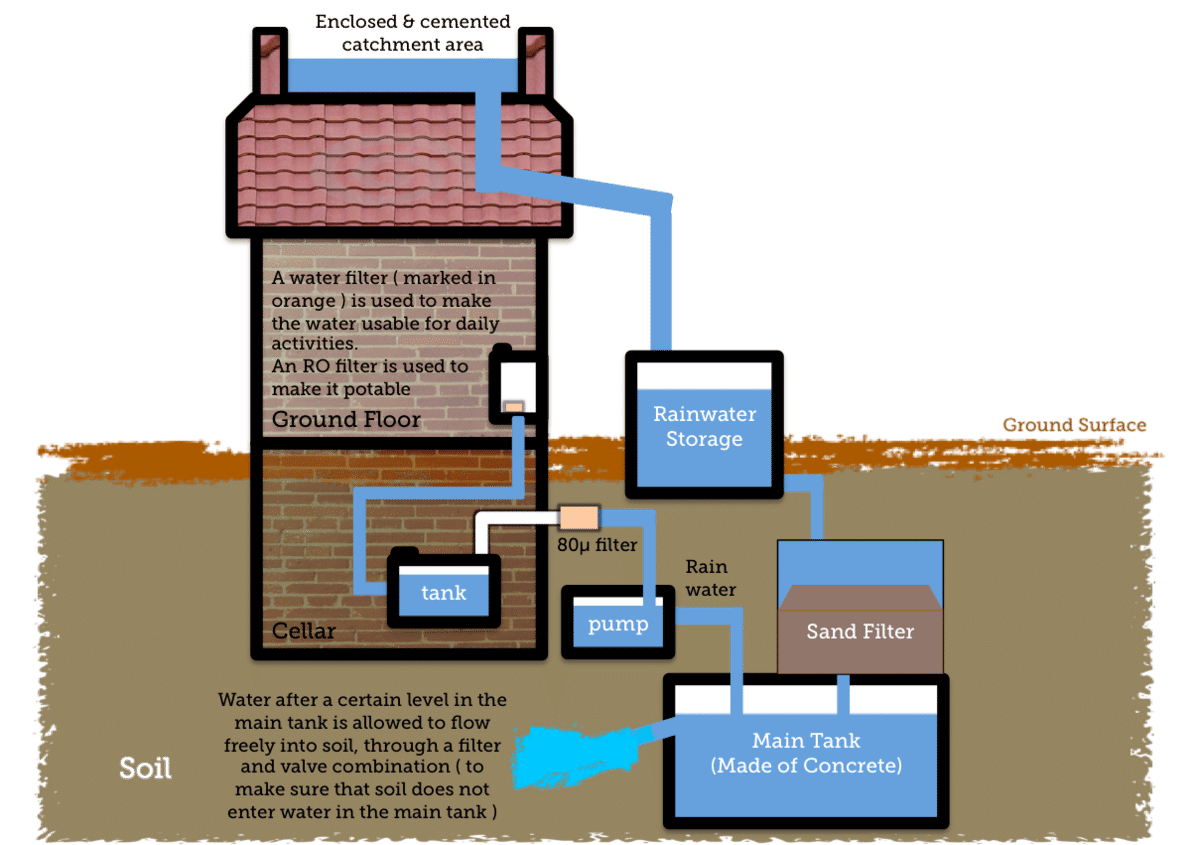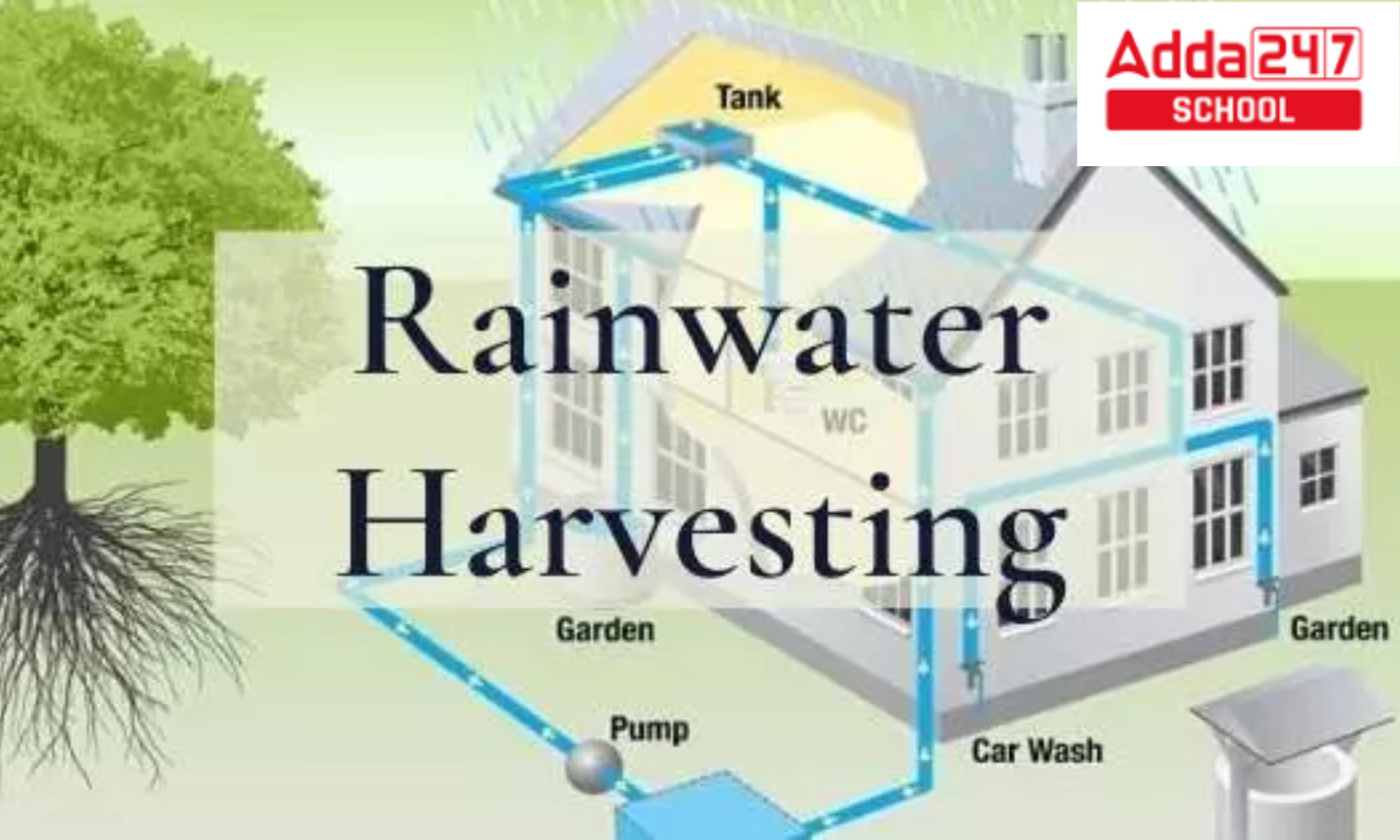Table of Contents
Rainwater Harvesting Project
The technique of gathering and preserving rainwater for later use is known as rainwater harvesting. It is an easy and efficient approach to lessen your dependency on municipal water supply and conserve water. Rainwater is useful for many things, such as drinking water, car washing, gardening, and irrigation. In this article, we will learn about an important project on this topic and know how to make this project for school. We will also learn the objectives and advantages of rainwater harvesting projects.
Rain Water Harvesting Project
Rain water harvesting Project (RWH) is the practice of collecting and storing rainwater as opposed to letting it flow off. Rainwater is gathered from a surface that resembles a roof and directed to a container with percolation, such as a tank, cistern, deep pit (well, shaft, or borehole), aquifer, or reservoir where it seeps down and replenishes the groundwater table. With the aid of nets or other instruments, dew and fog can also be gathered. Stormwater harvesting is different from rainwater harvesting since the runoff from roofs and other surfaces is often collected for storage and later utilization. Rain Water Harvesting Project recycled water can be used for irrigation, home use with correct handling, watering gardens and cattle, and domestic heating. A groundwater recharge or longer-term storage project may be undertaken with the gathered water.
Rainwater Harvesting Project Necessity
The lifeblood of our world is water. It satisfies human thirst, feeds crops, and maintains ecosystems. But fresh water is a scarce resource, and the expanding needs of the world’s population are placing enormous strain on this valuable supply. Rainwater collection has shown to be a clever and sustainable response to this problem. This article explores the idea of rainwater harvesting, including its significance, how it works, and the advantages it has for communities and the environment.
Rainwater Harvesting Project Definition
Rainwater harvesting Project Definition- One of the earliest and most straightforward ways to provide water for households on your own is through rainwater gathering, which has been practised for thousands of years in South Asia and other regions. Installations of Rainwater Harvesting Systems can be made to serve institutions like schools, hospitals, and other public facilities, as well as scales as diverse as homes, neighbourhoods, and communities.
Human Eye Definition, Diagram, Structure
Rain water Harvesting Project Drawing

Rainwater Harvesting System for Irrigation

Rainwater Harvesting System in households
Rainwater Harvesting Project Explanation
Water is an abiotic element of the environment that is valuable and necessary. As a result of water body contamination and a lack of water conservation, we are currently facing a water shortage. This is where the rain water harvesting comes into play. Rainwater harvesting is the process of gathering and storing precipitation using artificially constructed systems that drain from naturally occurring or artificially created catchment areas, such as rooftops, compounds, rock surfaces, hill slopes, and artificially restored impervious or semi-pervious land surfaces. This harvesting technique is cost-effective and environment friendly. It even increases the water supply and reduces its demand.
Methods of Rainwater Harvesting Class 10
In general, there are two methods for collecting rainwater: rooftop and surface runoff collection. Rainwater harvesting is the practise of gathering and storing rainwater for on-site re-use rather than letting it flow off. The water that is kept in storage is used for a variety of tasks, including irrigation and gardening.
1. Surface Runoff Harvesting
2. Rooftop Rainwater Harvesting
It is a technique for gathering rainwater at its source. Rooftop harvesting involves collecting rainwater from a building or home’s roof by turning it into a catchment.
It can either be directed to a synthetic recharge system or stored in a tank. If used properly, this strategy, which is less expensive and very beneficial, contributes to raising the local groundwater level.
All About Father Of Genetics- Gregor Mendel
Project on Rainwater Harvesting Components
The project on rainwater harvesting mainly constitutes of the following sub-components:
1. Catchment
The catchment of a rainwater harvesting system is the surface that directly receives rainfall. It could be an open area that is paved or unpaved, a terrace, or a courtyard.
2. Transportation
Rainwater from the roof should flow through the ground and into water pipes or drains that go to the system for storing and harvesting it. Water pipes must be UV resistant and the appropriate capacity (ISI HDPE/PVC pipes).
3. First Flush
The first flush is a mechanism used to remove the water from the initial shower. To prevent the potential contaminants from the atmosphere and the catchment roof from contaminating the storable/rechargeable water, the first rain shower must be rinsed off.
4. Filter
Since concerns have been expressed that rainfall can contaminate groundwater, there is some uncertainty regarding roof top rainwater harvesting. If the right filtration mechanism is not used, there is a slight chance that this worry will come to pass.
a. Sand Gravel Filter
These are often used filters that are built from brick masonry and have pebble, gravel, and sand fillets. Wire mesh should be used to divide each layer.
b. Charcoal Filter
In-situ or in a drum can be used to create charcoal filters. The drum or chamber should be filled with pebbles, gravel, sand, and charcoal as depicted in the illustration. Wire mesh should be used to divide each layer. If there is any odour, it is absorbed by the thin layer of charcoal.
c. PVC –Pipe filter
PVC pipe in the lengths of 1 to 1.20 metres can be used to create this filter; pipe diameter depends on the size of the roof. For roofs larger than 1500 square feet, 8 inches dia. pipe should be utilised instead of six inches dia. pipe. Wire mesh separates the pipe into three parts.
d. Sponge Filter
It is a straightforward filter fashioned from a PVC drum with a layer of sponge in the centre. It is the simplest and least expensive type of filter, suited for homes.
Planets Name In English And Hindi
What is Rainwater Harvesting Class 10?
Check out all details of the Rainwater Harvesting System Project for the Class 10 Students Board Exams.
Rain water Harvesting Project Aim
To determine whether rainwater harvesting systems in Panch Lok, Raj Nagar, Kavi Nagar, Kamla Nehru Nagar, and Shastri Nagar are feasible and designed appropriately.
Rainwater Harvesting Project Objectives
Finding the rainwater potential and its relationship with groundwater, calculating the runoff from different areas of the colony according to land use, calculating the number of recharging structures required for the colony, locating the various types of recharging structures, and proposing a design prototype for each zone and each land use are all goals of this study.
Water harvesting techniques include: Collecting rainwater from roofs and roadways; collecting runoff from nearby catchments; collecting seasonal floodwater from nearby streams; and conserving water by managing watersheds. Utilizing rainwater for home or agricultural purposes is a part of it.
Rainwater Harvesting Project Necessity
The majority of rain that falls on the surface has a tendency to evaporate quickly, leaving very little for groundwater replenishment. As a result, even for home usage, water is scarce in the majority of India’s regions. As a result, steps to ensure that rain falling over a region is absorbed as fully as possible through rainwater harvesting are required. These techniques include either storing the water for later use or recharging it into groundwater aquifers.
Rainwater Harvesting Project Benefits
- Increases groundwater table.
- reduces runoff that clogs drains and prevents roads from flooding.
- enables self-sufficiency in water supply and helps replenish home water needs during the summer and times of drought.
- It lowers the rate at which power is consumed when pumping groundwater. One metre of water level rise results in a 0.4 KWH reduction in energy use.
- Rainwater collection has helped communities in desert regions where rainfall is scarce.
Rainwater Harvesting Project Disadvantage
- If supplies aren’t cleaned/flushed before use, bird/animal droppings on catchment surfaces and guttering structures could pollute them.
- Algal development and invasion by insects, lizards, and rats are two problems that can occur in improperly built water jars and containers. If they are neglected, they may serve as a breeding ground for disease vectors.
Rainwater Harvesting Project Conclusion
The natural resources are under a significant deal of stress due to the expanding population and the increased demand for water. There will soon be a shortage of water worldwide due to the rapid depletion of underground reserves. This issue can be resolved if artificial methods are used. The necessity for and solution for rainwater harvesting in the Indirapuram neighbourhood of Ghaziabad are described in length in this study. In addition to helping with flood control, rainwater collection also helps with pollution control and continuous water supply.
7 Rainbow Colours Name In Order, Drawing, Vibgyor Meaning


 NEET Chemistry Syllabus 2025, Check Clas...
NEET Chemistry Syllabus 2025, Check Clas...
 NEET UG 2025 News: Check NEET Exam Mode
NEET UG 2025 News: Check NEET Exam Mode
 CBSE Board Exams 2025 Latest News- Recen...
CBSE Board Exams 2025 Latest News- Recen...





























